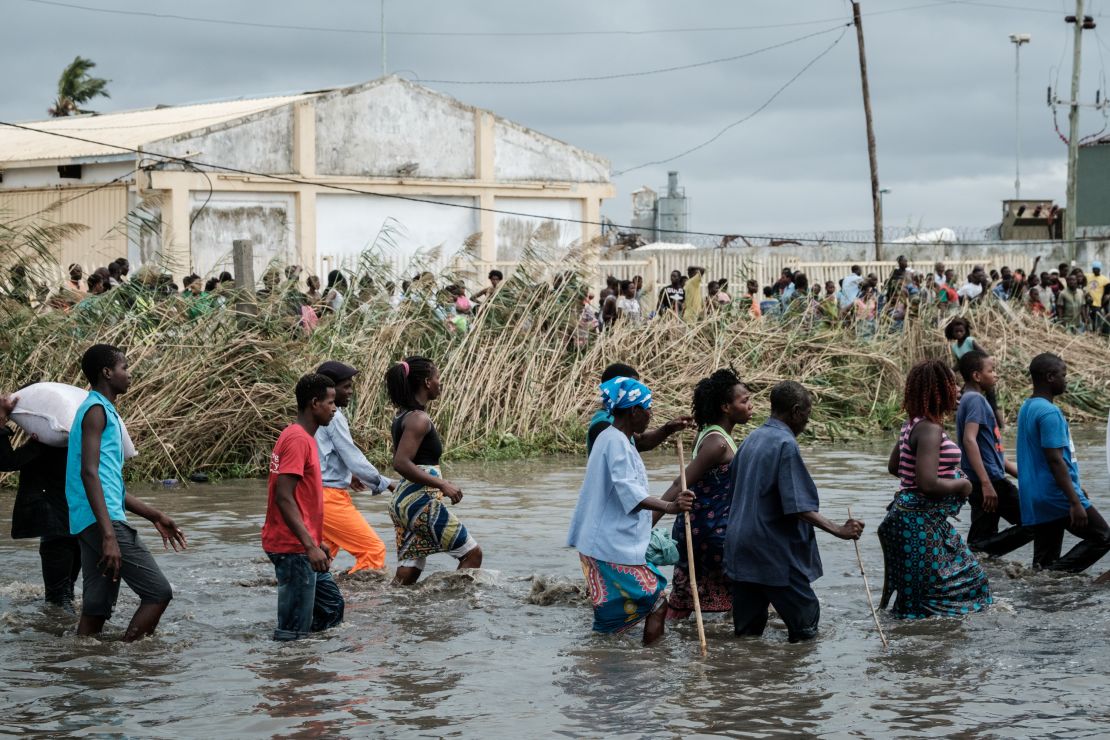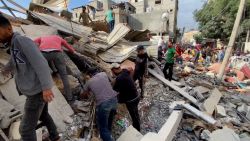As many as “300 to 400” bodies line the banks of a road out of the city of Beira in Mozambique, according to an eyewitness account, and flood waters have formed an inland ocean that is visible from outer space.
The harrowing scene, described by Zimbabwean Graham Taylor, suggests that the human toll of Cyclone Idai is likely to far exceed official estimates. It follows reports from aid agencies on the ground detailing how entire villages and towns have been completely flooded in the wake of last Thursday’s high-end Category 2 storm.
Taylor said the bodies were located on a 6-kilometer (3.7-mile) track of highway, where flood waters had created an inland ocean, submerging entire villages around a “densely populated” sugar cane plantation. The area is a mere fraction of the land in the southeast African nation left flooded after two major rivers burst their banks in the days following the storm.
The International Federation of the Red Cross and Red Crescent Societies (IFRC) said that the destruction left by the cyclone is “worse than we imagined” and warned that the humanitarian needs “will tragically only deepen in the coming weeks.”
In a statement, IFRC said that flooding creates ideal conditions for disease outbreaks.
“Already, some cholera cases have been reported in Beira along with an increasing number of malaria infections among people trapped by the flooding,” read the statement.
Flooding is so extreme in Buzi, central Mozambique, that the water can be seen in satellite images from outer space.

The area is home to some 200,000 people, and CNN spoke to survivors arriving at Praia Nova by boat on Friday.
One man, Abias Felipe, had arrived from the flooded village of Chikezana after surviving the cyclone.
“It broke everything – there’s nothing left there,” he told CNN, adding that rescue teams had started to arrive in the area.
“They’re starting to come but there’s still a lot of people trapped in their homes,” said Felipe. “They say there’s a lot more rain to come today and tomorrow.”
On Friday 700 survivors from Buzi gathered at the Escola Secundaria Samora Machel school in Beira after they were rescued.
At a press conference in Beira, Mozambique Prime Minister Carlos Agostinho do Rosário said the official number of people killed in Mozambique had climbed to 293, adding that “we believe that figure will rise.”
More than one week on from the storm’s initial impact, the United Nations confirmed that 259 lives were lost in Zimbabwe and 56 in Malawi.
But information has been slow to emerge and communication with affected areas remains limited. On Monday, Mozambican President Filipe Nyusi said that “everything indicates that we can have a record of more than 1,000 dead” – a figure that some experts now believe could be conservative.
The mortuary at the central hospital in Beira “is full and dozens of bodies need to be removed and handled in a dignified way,” according to ICRC. Beira is still flooded, which makes it impossible to bury bodies, ICRC said.
It is premature to say how many people have died while affected areas remain inaccessible, Stephen Fonseca, regional forensics manager at the International Committee of the Red Cross (ICRC), told CNN.
On Friday morning ICRC set up a new base in Chimoio, near the border with Zimbabwe. Fonseca said identifying victims is “a monumental task” that will take months or years rather than days or weeks.
“The agony of not knowing what happened to your loved one in a disaster like Cyclone Idai is indescribable,” Diane Araujo, an ICRC delegate deployed to Beira, said in a statement.
Araujo said the ICRC is sending staff to Malawi, Mozambique and Zimbabwe to help families who don’t have access to phone or internet find their missing relatives.
About 1.7 million people are affected by Cyclone Idai in Mozambique, Malawi and Zimbabwe, according to UNICEF.
“The situation on the ground remains critical,” said Christophe Boulierac, UNICEF spokesperson in Geneva, describing the scene in Beira.”There is no electricity or running water.”
Thousands of people are congregating in informal camps in desperate conditions, according to UNICEF representative Marco Luigi Corsi, who has traveled to affected areas.
Eyewitness account
Taylor, 62, who has lived in Mozambique for 10 years, became stranded on Saturday on the highway to Zimbabwe from Beira, where Cyclone Idai made landfall, after flood waters one-meter high blocked the road.
At 3 a.m. on Monday, he abandoned his car and joined the streams of people wading in the pitch black through the waters along the raised highway.
In the dark, he could hear people “sobbing and crying.”
As dawn broke, those sobs began to make sense as a “terrible sight” emerged, Taylor said.
“Dead bodies had floated up (and the) current of the flood water had washed the bodies up against the road,” said Taylor. “The road had subsided about 10 inches (25.5 centimeters). So these bodies had been washed up against the main highway.”
Taylor said the smell of bodies and livestock was palpable.
Hundreds of others were also attempting to make the congested seven-hour walk from the village of Lamego – about 90 kilometers (56 miles) inland from Beira – to Nhamatanda, on higher ground.In places where thecurrent of the flood waters was strong, about 50 people joined hands to make a human chain, said Taylor.
“I’m 6 foot 2 inches (187 centimeters), but the force of water at knee level was powerful,” Taylor said. “You had to pay attention and concentrate where you put your feet.”
Taylor said he saw an elderly woman carry her husband on her back.
On the road out of Beira, he said “the entire area, as far as I could see, was one lake of floodwater,” adding that groups of up to 10 people had climbed eucalyptus, cashew and mango trees waiting to be rescued.

But he also saw people heading back towards the flood zone.
“They said they couldn’t account for their families and wouldn’t leave until they could do,” he said.
Biblical scenes
Idai made landfall in Mozambique on midnight local time on Thursday, March 14, with 175 kph (109 mph) winds,
It wasn’t the strongest storm to have hit Mozambique, but the region had recently been deluged by heavy rains. After lingering off the coast for days, gathering strength, Idai finally dumped a huge amount of water on Beira – a city of 500,000 people – destroying “90%” of the area, according to aid agencies.
One week later, thousands of people remain missing across Mozambique, Malawi, and Zimbabwe. Millions of others across have been left destitute without food or basic services, according to reports.?

The high commissioner for Mozambique in the UK, Filipe Chidumo, said Wednesday that the country needs “a sustained effort on part of the Mozambican government as well as the international community” to help rescue stranded people, and provide, food, sanitation and water for those at risk.
“This is a big tragedy of biblical proportions,” he said, adding that major work will be needed, including the restoration of electricity, water and sanitation to prevent the emergence of waterborne diseases, as well as repairs to public infrastructure.
‘The soils had filled my mouth’

After hitting Mozambique, Cyclone Idai tore into Zimbabwe killing many people as they slept.
The 83-year-old husband of one Chimanimani resident was buried alive when their bedroom collapsed on them last Friday.?
“We were sleeping in the house around 10 p.m. in the evening and it was raining. It kept on pouring when rocks sliding from the hill started hitting our house,” said the 59-year-old.
“The stones we built our house with collapsed on us, and then I yelled, ‘oh my, I’m dying!’ The soils had filled my mouth, nose and ears. Water filled the house to almost my neck level … I started to shake my husband’s body to no avail. He was already dead.”

Nearby, another family had abandoned searching for their 16-year-old missing son, who they suspect is buried under the mud.
Efforts to bring aid to those affected by Cyclone Idai are under way in Zimbabwe. President Emmerson Mnangagwa’s government is airlifting food to some of the areas where people are still trapped.
Mnangagwa has declared March 23 and 24 national days of mourning.
“I want some shelter, I have none,” said one Chimanimani resident. “I have no blankets. No pots. My plates, sofas were all destroyed … I do not know if I will survive or not.”
A previous version of this story incorrectly attributed information to the IFRC. The story has been corrected to reflect that the reporting came from the ICRC.
Anna Cardovillis reported from Beira, Mozambique and Columbus Mavhunga reported from Chimanimani, Zimbabwe. Jenni Marsh wrote from Hong Kong and Jack Guy wrote from London. Farai Sevenzo also contributed to this report.

















